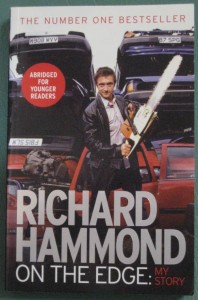I know you’re expecting Mondayitis but things are rather busy and I find it’s easier to write a book review than to find someone to answer Mondayitis, therefore you’re going to get book reviews until either I run out of books or things become less hectic.
Richard Hammond is that short guy on Top Gear UK, when I say short I don’t mean my height but short in comparison with two men over six foot. Funnily enough he’s also the youngest and best looking but they’re all rather mad and do more than rather mad things. In 2006 he was trying to drive ‘very fast’ in a Dragster, yes he succeeded, but he also succeeded in flipping the entire car with the help of a burst tyre ending up with brain damage. This book is the abridged story of his accident and subsequent recovery.

The book starts off giving us some valuable background about Hammond’s childhood and we get to see why he’s happiest doing silly and dangerous stunts while trying to entertain, this is so ingrained in his psyche that when he’s not in control of his brain following the accident he still sits in hospital trying to entertain everyone who comes to visit him despite not having the physical energy or understanding entirely what’s going on. He describes many times where he’s done silly and dangerous stunts on his bicycle only to look around and make sure someone was looking, apparently he was quite satisfied with the time he could see bone after one such stunt went slightly wrong.
We also get a very good description of the car and all the events leading up to the final drive and then finally a blow by blow description of how it felt to be inside the car and what was actually happening, we get one or more paragraphs of details that happened in a fraction of a second and correlates that with the information they received from the instruments measuring everything.
After the accident Mindy takes over narration for a good deal of the book before they tag team it. Mindy is Hammond’s wife and they have two little girls and an au pair. She does an absolutely amazing job of being there throughout for Hammond while also being there for their daughters and also keeping family and friends updated on progress. I look at what she did and am absolutely amazed at her strength and will power.
Both Hammonds don’t seem to have pulled their punches with information about the effects an accident has on the brain and how the recovery works so it would make an interesting case study for anyone looking after someone with brain damage, it would make it easier to understand and to help. One of the qualities you need is patience as short term memory is one of the things you lose. Hammond would be delighted to find his favourite dish on the lunch menu, order it then forget only to be delighted when his favourite dish arrived in front of him. He’d talk about going outside for a cigarette only to forget and have the same conversation seconds later. Entertaining him with the newspaper was easy as he could read the same article many times without remembering any of it so each time he read it was as if he was reading it for the first time.
One thing he fixated on was Lego so it was duly bought and given to him, the doctors were quite happy with this as a form of therapy as transforming the 2D instructions into 3D models is good for the brain.
A few days ago I was one of a team who unhappily helped a man through an epileptic seizure, it wasn’t a pleasant experience and I hope it’s his last. I mention this here as watching him recover was interesting and I felt his recovery was roughly the same as Hammond’s. There was the coming to, then the starting to understand where he was, followed by recognition, and somewhere in there was speech and short term memory problems. This all only took an hour and a half whereas Hammond took a few more days to go through these stages and it was rather more pronounced.
I found this book to be well written and highly readable. Most technical data was explained so even someone like me who has trouble understanding these things could understand it. Between them they manage to show us recovery both from within and without as they describe the same thing from both aspects. If a book like this could be said to be enjoyable then yes, it is and I enjoyed it despite the tears it created.

